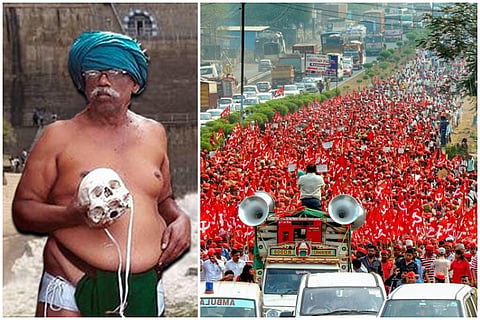

Tamil Nadu is watching Mumbai with interest. After all, farmers from Maharashtra managed to do what the Cauvery delta farmers could not.
While over 100 farmers from Tamil Nadu sat in protest in New Delhi for 41 days last year and went back home empty-handed, the Maharashtra farmers managed to meet Chief Minister Devendra Fadnavis the day they landed in Mumbai. A majority of their demands were met, although it is a different matter whether the assurances given will be fulfilled or not.
“Our Tamil Nadu Chief Minister Edappadi K Palaniswami also came and met us finally. CM is no big deal. But the Prime Minister did not meet us because he thinks we are the sin of the nation, fourth-grade citizens who should be met only at election time,” says a bitter P Ayyakannu, who spearheaded the Tamil Nadu farmers agitation.
But Ayyakannu's stout defence apart, the difference in approach between the two agitations perhaps played a part in how the corridors of power responded.
One, the sheer optics of numbers in Maharashtra. It conveyed anger, unrest, pain and suffering. The fact that 35,000 farmers – many of them daily-wage farm labourers – had left work on the fields for six days, meant they were serious about getting their voice heard.
The sight of so many farmers, walking 180 km in the hot sun, getting blisters in their feet, moved even the Mumbaikar, usually obsessed with the pace of his/her own life. The fact that the protest was completely peaceful and disciplined only added value to their demands. As well-known rural affairs journalist and author P Sainath said, they managed to make the deaf hear and the blind see.
In contrast, the Tamil Nadu protest relied almost entirely on the shock element. The farmers in order to demonstrate that back home it was a matter of life and death, had carried with them skulls and bones of farmers who had either committed suicide or died of shock, unable to repay their huge farm debts. The farmers stripped themselves to the bare minimum, tonsured themselves, pretended to eat rats or food served on the road and even ran naked in front of the PM's residence. This ensured they got media attention but little else.
“The histrionics took away the attention from what they were trying to communicate,” says C Ramanjaneyelu, agriculture scientist. “Also, the character these agitations take on depends on the leadership and the inputs they get. In Maharashtra, a number of academicians were also involved and they had also learnt from the failure of the Tamil Nadu protest.”
The Tamil Nadu farmers also suffered from another disadvantage. The state government, because of the political instability within the AIADMK, was seen as a powerless entity and for reasons known best to them, the farmers did not adequately mobilise the Opposition's support for themselves. All they got were guest appearances by the likes of Kanimozhi and Vaiko in Delhi. In contrast, a Left-affiliated union helped organise the march from the districts to Mumbai and once they reached the state capital, there was support from other non-BJP parties, including the Shiv Sena and Maharashtra Navnirman Sena.
The fact that the BJP does not have a serious political stake in Tamil Nadu also determined their hands-off approach to the state's farmers. Coupled with it was the apprehension that any concessions made could have adverse repercussions in the upper-riparian state of Karnataka, where the BJP hopes to come to power.
Then of course, there is also the language issue. With Hindi as the link language, it was easier for the Maharashtra farmer to communicate his or her woes to the country at large through the national media. The Tamil farmer found it difficult to articulate his woes to a Delhi media, largely ignorant of Tamil.
The Tamil Nadu farmer had to only look at the success of the Marina uprising in support of another agrarian issue, Jallikattu or the bull taming sport in January 2017. Thousands of people in Chennai, including students and professionals, turned up to support an issue that was dovetailed into Tamil identity and Tamil pride. Given that agriculture at the end of the day is a state subject, a protest in Chennai would have possibly ensured a better response than the failed effort in Delhi.
But what was common to the two protests was the manner in which the privileged classes reacted. Questions were raised over who was funding the Tamil Nadu protest in Delhi, going into specific details of Ayyakannu's assets. While an individual farmer may be comparatively well off, it does not take away from the crisis on the ground and what Delhi failed to realise is that it must take extreme distress for anyone to strip himself of his dignity in public, whatever the allurement.
Likewise, every effort was made to denigrate the Maharashtra farmer, labelling their support base in Mumbai as “urban naxals”. These are well-entrenched defenders of the ruling class, possibly looking for quid pro quo for their attack on anyone who seeks to disturb the status quo. They smell an anti-BJP conspiracy in everything, more so here because red flags dominated the march. The Left too erred as it should have on its own, taken a back seat and allowed the march to look apolitical.
On Sunday night, the farmers decided to march to Azad Maidan so that they did not come in the way of students who had to be on time for their Board Exams on Monday morning. That one gesture showed the farmers have their hearts in the right place.
Can one say the same about the rest of India?